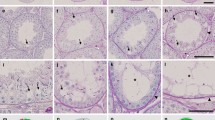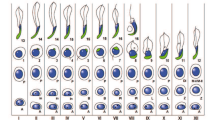Abstract
We developed a technique to analyze the high-resolution three-dimensional (3D) structure of seminiferous tubules. It consists of segmentation of tubules in serial paraffin sections of the testis by marking the basement membrane with periodic acid–Schiff or a fluorescent anti-laminin antibody followed by 3D reconstruction of tubules with high-performance software. Using this method, we analyzed testes from mice at different ages and accurately elucidated the 3D structure of seminiferous tubules, including the number and length of tubules as well as the numbers of connections with the rete testis, branching points, and blind ends. We also developed a technique to identify the precise spermatogenic stage and cellular composition of the seminiferous epithelium. It consists of the combination of lectin histochemistry for acrosomes and immunohistochemistry for specific cell markers visualized with fluorescence. Using this method, we examined seminiferous tubules from normal mice and counted the number of each cell type at each stage, and thereby established a quantitative standard for the cellular composition of the seminiferous epithelium. We then investigated seminiferous epithelia from genetically modified infertile mice deficient in certain cell adhesion molecules and revealed characteristic abnormalities in the cellular composition. We also analyzed the distribution and direction of spermatogenic waves along the length of adult seminiferous tubules as well as the site of the first onset of spermatogenesis in postnatal seminiferous tubules. These methods will be useful for investigating the structure and function of seminiferous tubules in mice and humans under normal and pathological conditions.







Similar content being viewed by others
References
Abercronbie M (1946) Estimation of nuclear population from microtome sections. Anat Rec 94:239–247
Agrimson KS, Onken J, Mitchell D, Topping TB, Chiarini-Garcia H, Hogarth CA, Griswold MD (2016) Characterizing the spermatogonial response to retinoic acid during the onset of Spermatogenesis and following synchronization in the neonatal mouse testis. Biol Reprod 95:1–15
Ahmed EA, de Rooij DG (2009) Staging of mouse seminiferous tubule cross-sections. Methods Mol Biol 558:263–277
Allen BM (1904) The embryonic development of the ovary and testis of the mammals. Am J Anat 3:89–154
Bremer JL (1911) Morphology of the tubules of the human testis and epididymis. Am J Anat 11:393–417
Buaas FW, Kirsh AL, Sharma M, McLean DJ, Morris JL, Griswold MD, de Rooij DG, Braun RE (2004) Plzf is required in adult male germ cells for stem cell self-renewal. Nat Genet 36:647–652
Christensen AK (1975) Leydig cells. In: Hamilton DW, Greep RO (eds) Handbook of physiology, vol 5. Male reproductive system. American Physiological Society, Washington DC, pp 57–94
Clermont Y (1972) Kinetics of spermatogenesis in mammals: seminiferous epithelium cycle and spermatogonial renewal. Physiol Rev 52:198–236
Clermont Y, Harvey SC (1965) Duration of the cycle of the seminiferous epithelium of normal, hypophysectomized and hypophysectomized-hormone treated albino rats. Endocrinology 76:80–89
Clermont Y, Huckins C (1961) Microscopic anatomy of the sex cords and seminiferous tubules in growing and adult male albino rats. Am J Anat 108:79–97
Clermont Y, Oko R, Hermo L (1993) Cell biology of mammalian spermiogenesis. In: Desjardin C, Ewing LL (eds) Cell and molecular biology of the testis. Oxford University Press, New York/Oxford, pp 332–376
Combes AN, Lesieur E, Harley VR, Sinclair AH, Little MH, Wilhelm D, Koopman P (2009) Three-dimensional visualization of testis cord morphogenesis, a novel tubulogenic mechanism in development. Dev Dyn 238:1033–1041
Courot M, Hochereau-de-Reviers MT, Ortavant R (1970) Spermatogenesis. In: Johnson AD, Gomes WR, VanDemark NL (eds) The testis 1. Academic, New York, pp 339–432
Curtis GM (1918) The morphology of the mammalian seminiferous tubule. Am J Anat 24:339–394
Davis JR, Langford GA, Kirby PJ (1970) The testicular capsule. In: Johnson AD, Gomes WR, VanDemark NL (eds) The testis 1. Academic, New York, pp 281–337
De Kretser DM, Kerr JB (1988) The cytology of the testis. In: Knobil E, Neill J (eds) The physiology of reproduction. Raven, New York, pp 837–932
DeFalco T, Potter SJ, Williams AV, Waller B, Kan MJ, Capel B (2015) Macrophages contribute to the spermatogonial niche in the adult testis. Cell Rep 12:1107–1119
Drumond AL, Meistrich ML, Chiarini-Garcia H (2011) Spermatogonial morphology and kinetics during testis development in mice: a high-resolution light microscopy approach. Reproduction 142:145–155
Fawcett DW, Neaves WB, Flores MN (1973) Comparative observations on intertubular lymphatics and the organization of the interstitial tissue of the mammalian testis. Biol Reprod 9:500–532
Felix W (1912) The development of the urinogenital organs. In: Keibel F, Mall FP (eds) Manual of human embryology II. JB Lippincott, Philadelphia, pp 752–979
Gardner PJ (1966) Fine structure of the seminiferous tubule of the Swiss mouse. The spermatid. Anat Rec 155:235–249
Gardner PJ, Holyoke EA (1964) Fine structure of the seminiferous tubule of the Swiss mouse. I. The limiting membrane, Sertoli cell, spermatogonia, and spermatocytes. Anat Rec 150:391–404
Hess RA, Franca LR (2005) Structure of the Sertoli cell. In: Griswold M, Skinner M (eds) Sertoli cell biology. Academic, New York, pp 19–40
Hess RA, Franca LR (2008) Spermatogenesis and cycle of the seminiferous epithelium. Adv Exp Med Biol 636:1–15
Huber GC, Curtis GM (1913) The morphology of the seminiferous tubules of mammalia. Anat Rec 7:207–219
Hume DA, Halpin D, Charlton H, Gordon S (1984) The mononuclear phagocyte system of the mouse defined by immunohistochemical localization of antigen F4/80: macrophages of endocrine organs. Proc Natl Acad Sci USA 81:4174–4177
Ikami K, Tokue M, Sugimoto R, Noda C, Kobayashi S, Hara K, Yoshida S (2015) Hierarchical differentiation competence in response to retinoic acid ensures stem cell maintenance during mouse spermatogenesis. Development 142:1582–1592
Imai T, Kawai Y, Tadokoro Y, Yamamoto M, Nishimune Y, Yomogida K (2004) In vivo and in vitro constant expression of GATA-4 in mouse postnatal Sertoli cells. Mol Cell Endocrinol 214:107–115
Kluin PM, de Rooij DG (1981) A comparison between the morphology and cell kinetics of gonocytes and adult type undifferentiated spermatogonia in the mouse. Int J Androl 4:475–493
Lammers JH, Offenberg HH, van Aalderen M, Vink AC, Dietrich AJ, Heyting C (1994) The gene encoding a major component of the lateral elements of synaptonemal complexes of the rat is related to X-linked lymphocyte-regulated genes. Mol Cell Biol 14:1137–1146
Leblond CP, Clermont Y (1952a) Definition of the stages of the cycle of the seminiferous epithelium in the rat. Ann N Y Acad Sci 55:548–573
Leblond CP, Clermont Y (1952b) Spermiogenesis of rat, mouse, hamster and guinea pig as revealed by the “periodic acid-fuchsin sulfurous acid” technique. Am J Anat 90:167–215
Leeson TS, Cookson FB (1974) The mammalian testicular capsule and its muscle elements. J Morphol 144:237–253
Meistrich ML, Hess RA (2013) Assessment of spermatogenesis through staging of seminiferous tubules. Methods Mol Biol 927:299–307
Mori H, Christensen AK (1980) Morphometric analysis of Leydig cells in the normal rat testis. J Cell Biol 84:340–354
Nakata H, Wakayama T, Sonomura T, Honma S, Hatta T, Iseki S (2015a) Three-dimensional structure of seminiferous tubules in the adult mouse. J Anat 227:686–694
Nakata H, Wakayama T, Takai Y, Iseki S (2015b) Quantitative analysis of the cellular composition in seminiferous tubules in normal and genetically modified infertile mice. J Histochem Cytochem 63:99–113
Nakata H, Sonomura T, Iseki S (2017a) Three-dimensional analysis of seminiferous tubules and spermatogenic waves in mice. Reproduction 154:569–579
Nakata H, Wakayama T, Asano T, Nishiuchi T, Iseki S (2017b) Identification of sperm equatorial segment protein 1 in the acrosome as the primary binding target of peanut agglutinin (PNA) in the mouse testis. Histochem Cell Biol 147:27–38
Nel-Themaat L, Vadakkan TJ, Wang Y, Dickinson ME, Akiyama H, Behringer RR (2009) Morphometric analysis of testis cord formation in Sox9-EGFP mice. Dev Dyn 238:1100–1110
Oakberg EF (1956a) A description of spermiogenesis in the mouse and its use in analysis of the cycle of the seminiferous epithelium and germ cell renewal. Am J Anat 99:391–413
Oakberg EF (1956b) Duration of spermatogenesis in the mouse and timing of stages of the cycle of the seminiferous epithelium. Am J Anat 99:507–516
Perey B, Clermont Y, Leblond CP (1961) The wave of the seminiferous epithelium in the rat. Am J Anat 108:47–77
Roosen-Runge EC (1962) The process of spermatogenesis in mammals. Biol Rev Camb Philos Soc 37:343–377
Roosen-Runge EC, Giesel LO (1950) Quantitative studies on spermatogenesis in the albino rat. Am J Anat 87:1–30
Russell LD, Ettlin RA, Sinha Hikim AP, Clegg ED (1990) Histological and histopathological evaluation of the testis. Cache River, Vienna
Silván U, Aréchaga J (2012) Anatomical basis for cell transplantation into mouse seminiferous tubules. Reproduction 144:385–392
Steinberger E, Steinberger A (1975) Spermatogenic function of the testis. In: Greep RO, Hamilton DW (eds) Male reproductive system. American Physiological Society, Washington, pp 1–10 (Handbook of Physiology, Section 7: Endocrinology, Vol. 5)
Torrey TW (1945) The development of the urinogenital system of the albino rat. II. The gonads. Am J Anat 76:375–397
Wakayama T, Nakata H, Kumchantuek T, Gewaily MS, Iseki S (2015) Identification of 5-bromo-2′-deoxyuridine-labeled cells during mouse spermatogenesis by heat-induced antigen retrieval in lectin staining and immunohistochemistry. J Histochem Cytochem 63:190–205
Acknowledgements
I am grateful to Prof. Shoichi Iseki (Kanazawa University, Komatsu University) for his constant encouragement of and contribution to this work. This work was supported by MEXT KAKENHI grant no. JP16K18976, and the Takeda Science Foundation, Ichiro Kanehara Foundation, and Sumitomo Foundation.
Author information
Authors and Affiliations
Corresponding author
Ethics declarations
Conflict of interest
The author declares that there are no conflicts of interest.
Rights and permissions
About this article
Cite this article
Nakata, H. Morphology of mouse seminiferous tubules. Anat Sci Int 94, 1–10 (2019). https://doi.org/10.1007/s12565-018-0455-9
Received:
Accepted:
Published:
Issue Date:
DOI: https://doi.org/10.1007/s12565-018-0455-9




